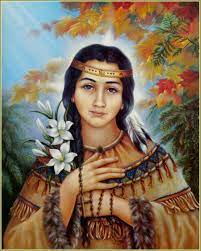HOMILY EASTER SEASON WEEK 02 06 – Year I
Balancing Prayer and Ministry, Contemplation and Action
Memorial: St. Kateri Tekakwitha
(Acts 6:1-7; Ps 33; Jn 6:16-21)
*******************************************************
Noted spiritual writer and speaker, Fr. Richard Rohr OFM, founded a Centre for Action and Contemplation in Albuquerque, New Mexico, some years ago.
That prophetic gesture provides a fitting backdrop to today’s readings and liturgy that, along with honoring St. Kateri Tekakwitha, invites us to balance prayer and ministry, contemplation and action in our lives.
The first reading highlights both those dimensions of a Christian life – prayer and service. The apostles devoted themselves to prayer and the Word of God. In their desire to not neglect the Word of God, they chose deacons full of faith and the Holy Spirit, laid their hands on them and mandated them to serve the practical needs of the early church. This was the birth of the deaconate in the church.
This passage adds the critical element of service to the description of the early church in Acts 2:42 and the four characteristics to which it was dedicated – prayer, scripture, fellowship and the Eucharist. The added emphasis on service provides a fuller picture of the birth of Christianity and a model for us to emulate as descendants of these ancestors in the faith.
In the gospel, however, the emphasis is on prayer, modeled by Jesus himself whom, we are told, often withdrew to the mountain by himself to pray. Elsewhere we are told he sometimes spent entire evenings communing with the Father. It is that rootedness in the Father’s love for him, nurtured by an intimate relationship of prayer, that allowed him to walk on the stormy sea, the dwelling place of sea monsters and darkness. It is significant that in the process of doing so, he made a point of dispelling the fear in the hearts of the disciples in the boat.
This incident becomes part of the ongoing process of the self-revelation of Jesus to his disciples. In one passage, Jesus places himself above the Torah which was the ultimate divine authority for the Jews (“You have heard it said … but I say to you …”). Here, by walking on the water he reveals he has power over any darkness and evil in this world, symbolized by the depths of the sea wherein lurked the legendary monster Leviathan according to Jewish belief.
Putting the two readings together, we are given the invitation to balance action and contemplation, ministry and prayer in our lives, and not neglect either one.
Stephen Binz wrote a book entitled Transformed by God’s Word exploring the power of Lectio Divina (praying with scripture) and Visio Divina (praying with icons or biblical art). Here is what he says about prayer: “God desires us to so assimilate scripture that it becomes metabolized in works of mercy, healing and reconciliation. By being digested and metabolized into a form that we may use for God’s reign in the world, the sacred text is transformed through us with God’s grace into witness and service.”
Binz combines both lectio and visio divina into six stages: lectio – reading God’s word; visio – pondering an icon based on that passage; meditatio – meditating on what God is saying to us through both word and art; oratio – praying with the passage and the icon; contemplatio – just being in the presence of the Lord, again through both word and art, and finally, operatio – responding to both word and icon through loving action.
 Today we honor St. Kateri Tekakwitha. The first North American Indigenous woman to be canonized, Kateri is often called the Lily of the Mohawks. She was born in 1656, on the southern bank of the Mohawk River at Osserneon (Auriesville, NY). Her mother was a Christian Algonquin from Trois-Rivières, Quebec, and her father a non-Christian Mohawk Turtle clan chief. When Kateri was four years old, a small pox epidemic killed her parents and her brother, leaving her with seriously impaired eyesight and a disfigured face. What she could not see with her physical eyes, she saw with the eyes of her soul into the mysteries of her faith.
Today we honor St. Kateri Tekakwitha. The first North American Indigenous woman to be canonized, Kateri is often called the Lily of the Mohawks. She was born in 1656, on the southern bank of the Mohawk River at Osserneon (Auriesville, NY). Her mother was a Christian Algonquin from Trois-Rivières, Quebec, and her father a non-Christian Mohawk Turtle clan chief. When Kateri was four years old, a small pox epidemic killed her parents and her brother, leaving her with seriously impaired eyesight and a disfigured face. What she could not see with her physical eyes, she saw with the eyes of her soul into the mysteries of her faith.
Inspired by Jesuit missionaries from an early age, Tekakwitha was baptized on Easter Sunday 1676 and assumed the name Kateri, likely in honor of Saint Catherin of Sienna. The following year, due to persecution in her community, Kateri escaped to Kahnawake on the St Lawrence River opposite Tiohtiake (Montreal). She had a strong devotion to the Eucharist, a deep concern for others and spent hours praying in the woods. She died on April 17, 1680 and was canonized in 2012. Those present at her death witnessed her scarred face being miraculously healed and transformed into her original beauty. Kateri is protectress of Canada, patron saint of ecology, those who have lost their parents, and World Youth Day.
The Eucharist is itself a balance of prayer and ministries; worship and liturgical action; communion with the Lord and a commission to go out and live the Eucharist in concrete acts of love and charity.
So, let us heed the readings today and respond by balancing prayer and ministry, contemplation and action in our lives, as did St. Kateri Tekakwitha.



